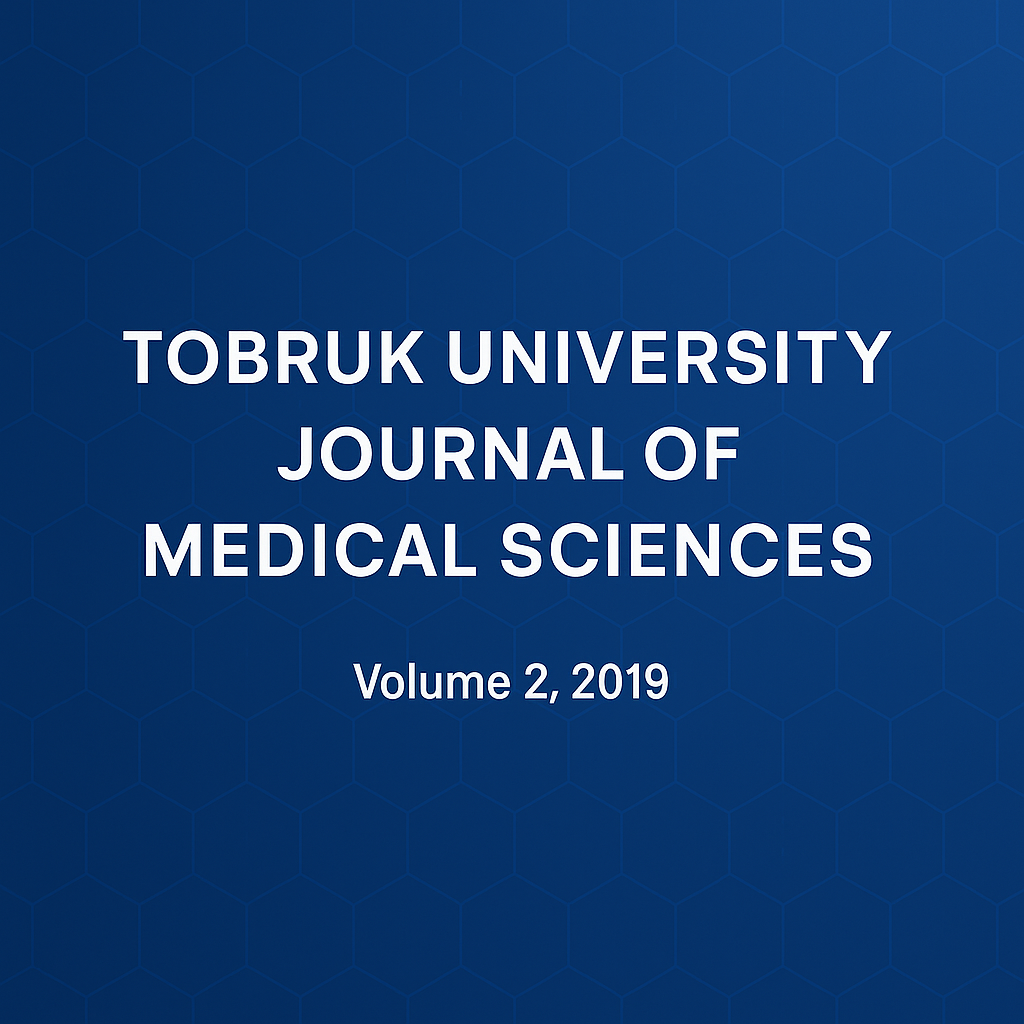Incidence of Acute Onset Endophthalmitis after Cataract Extraction Surgery at Tripoli Eye Hospital.
DOI:
https://doi.org/10.64516/t393hc84Keywords:
Endophthalmitis, phacoemulsification, Cornea, CataractAbstract
The aim of this study was to observe the incidence of acute onset endophthalmitis after cataract surgery in Tripoli Eyes Hospital between January 2015 until December2017. A retrospective study was reviewed all cases during three years by reviewing electronic surgical records.The study recorded the clinical and the microbial reultes of the recorded cases within the 6 weeks after cataract surgery . The study found that the The median age of patients was 74 years. The mean duration from day of cataract surgery to the day of diagnosis with endophthalmitis was 10 days. 5 of the 8 vitreous isolates produced culture positive growth. The 3 culture negative cases presented on postoperative days 5, 10 and 14.,topical 2% lidocaine gel was used in two (67%) before povidone-iodine preparation. Of the patients with endophthalmitis after a temporal clear cornea approach to phacoemulsification, 2 achieved a final visual acuity of counting finger or better, and 2 had a final visual acuity of hand motions or worse. One patient had a poor visual outcome due to endophthalmitis- not responding to the treatment ended with evisceration, whereas the other had a poor outcome .The study concluded thatthe incidence of endophthalmitis after clear cornea phacoemulsification (0.10%) was lower than the incidence after other approaches to cataract surgery (0.02%) in the current study,
References
1. Aaberg TM Jr., Flynn HW Jr., Schiffman J, Newton J(1998). Nosocomial acute-onset postoperative endophthalmitis survey. Ophthalmology;105:1004 –1010.
2. Eifrig CWG, Flynn HW, Jr., Scott IU, Newton J. (2002)Acute-onset postoperative endophthalmitis: review of incidence and visual outcomes. Ophthalmic Surg Lasers;33:373–378.
3. McDonnell PJ, Taban M, Sarayba M, et a(l2003). Dynamic morphologyof clear corneal cataract incisions. Ophthalmology;110:2342–2348.
4. Cooper BA, Holekamp NM, Bohigian G, Thompson PA(2003).Case-control study of endophthalmitis after cataract surgerycomparing scleral tunnel and clear corneal wounds. Am JOphthalmol;136:300 –305.
5. Nagaki Y, Hayasaka S, Kadoi C, et al(2003). Bacterial endophthalmitisafter small-incision cataract surgery: effect of incisionplacement and intraocular lens type. J Cataract RefractSurg;29:20 –26.
6. Colleaux KM, Hamilton WK(2000). Effect of prophylactic antibioticsand incision type on the incidence of endophthalmitisafter cataract surgery. Can J Ophthalmol;35:373–378
7. . Maloof A, Saw V. Prophylactic intracameral vancomycin. J(2004).Cataract Refract Surg;30:1610.
8.Wolner B, Liebmann JM, Sassani JW, et al. Late bleb- associatedendophthalmitis after trabeculectomy with adjunctive 5- fluorouracil.Ophthalmology 1991;98:1053–1060.
9. Mayer E, Cadman D, Ewings P, et al. (2003).A 10 year retrospectivesurvey of cataract surgery and endophthalmitisin a single eye unit: injectable lenses lower theincidence of endophthalmitis. Br J Ophthalmol;87:867– 869.
10.Buzard K, Liapis S. (2004). Prevention of endophthalmitis. J CataractRefract Surg;30:1953–1959.
11.Mandal K, Hildreth A, Farrow M, Allen D(2004). Investigationinto postoperative endophthalmitis and lessons learned. JCataract Refract Surg;30:1960 –1965.
12. Semmens JB, Li J, Morlet N, Ng J(2003). Trends in cataractsurgery and postoperative endophthalmitis in westernAustralia (1980 –1998): the endophthalmitis populationstudy of western Australia. ClinExpOphthalmol;31:213–219.
13.Kamalarajah S, Silvestri G, Sharma N, et a(l2004). Surveillance ofendophthalmitis following cataract surgery in the UK. Eye;18:580 –587. 14.Wong TY, Chee SP(2004). The epidemiology of acute endophthalmitis aftercataract surgery in an asian population. Ophthalmology;111:699 –705.
15. National Control & Prevention of Blindness Data. Monthwise 16.performance of cataract surgery during 2008 2009. Ministry of Health & Family Welfare, Government of India, New Delhi, India. 2009. Available from http://mohfw.nic.in/Cataract%20Performance%20updated.xls. Accessed January 14, 2009
17. Miller JJ, Scott IU, FlynnHWJr, Smiddy WE, Newton J, Miller D.( 2005) Acute-onset endophthalmitis after cataract surgery (2000– 2004): incidence, clinical settings, and visual acuity outcomes after treatment. Am J Ophthalmol; 139:983–987
18.Bell CM, Hatch WV, Cernat G, UrbachDR(2007). Surgeon volumes and selected patient outcomes in cataract surgery. Ophthalmology; 114:405–410
19.Chandra SR. Global blindness; Vision 2020: the right to sight [editorial].( 2008)Arch Ophthalmol; 126:145
20. Foster A, Resnikoff S. The impact of Vision 2020 on global blindness. Eye 2005; 19:1133–1135
21. Murthy GVS, Gupta SK, John N, Vashist P. (2008)Current status of cataract blindness and Vision 2020: the right to sight initiative in India. Indian J Ophthalmol; 56:489–494. Available at: http://www.ijo.in/temp/IndianJOphthalmol566489-4685979_130059.pdf.
22.Resnikoff S, Pascolini D, Etya’ale D, Kocur I, Pararajasegaram R, Pokharel GP, Mariotti SP(2002). Global data on visual impairment in the year. Bull World Health Organ 2004; 82:844–851. Available at: http://www.who.int/bulletin/volumes/82/11/en/844arabic.pdf. Accessed January 14, 2009
23. The Eye Diseases Prevalence Research Group. Causes and prevalence of visual impairment among adults in the United States. Arch Ophthalmol 2004; 122:477–485
24.Natchiar G, Robin AL, Thulasiraj R, KrishnaswamyS(1994). Attacking the backlog of India’s curable blind; the Aravind Eye Hospital model. Arch Ophthalmol; 112:987–993
25.Venkatesh R, Tan CSH, Singh GP, Veena K, Krishnan KT, Ravindran RD.( 2009)Safety and efficacy of manual small incision cataract surgery for brunescent and black cataracts. In press, Eye
26. Gupta A, Gupta V, Gupta A, Dogra MR, Pandav SS, Ray P, Chakraborty A(2003). Spectrum and clinical profile of post cataract surgery endophthalmitis in North India. Indian J Ophthalmol; 51:139–145. Available at: http://www.ijo.in/temp/IndianJOphthalmol512139-4696518_130245.pdf. Accessed January 15,2009.
27. Malhotra S, Mandal P, Patanker G, Agrawal D. (2008)Clinical profile and visual outcome in cluster endophthalmitis following cataract surgery in Central India. Indian J Ophthalmol;56:157–158.Available at: http://www.ijo.in/article.asp?issnZ0301-4738;yearZ 2008;volumeZ56;issueZ2;spageZ157;epageZ158;aulastZMalhotra. Accessed January 15, 2009
28.Mollan SP, Gao A, Lockwood A, Durrani OM, Butler L. (2007)Postcataractendophthalmitis: incidence and microbial isolates in a United Kingdom region from 1996 through 2004. J CataractRefractSurg; 33:265–268; erratum, 759
29.Montan P, Lundstro ̈m M, Stenevi U, Thorburn W.( 2002).Endophthalmitis following cataract surgery in Sweden. The 1998 national prospective survey. ActaOphthalmolScand; 80: 258–261
30.West ES, Behrens A, McDonnell PJ, Tielsch JM, Schein OD.
31.The incidence of endophthalmitis after cataract surgery among the U.S. Medicare population increased between 1994 and 2001. Ophthalmology 2005; 112:1388–1394
32.Taban M, Behrens A, Newcomb RL, Nobe MY, Saedi G, Sweet PM, McDonnell PJ. (2005).Acute endophthalmitis following cataract surgery; a systematic review of the literature. Arch Ophthalmol; 123:613–620 33.ESCRS Endophthalmitis Study Group. Prophylaxis of postoperative endophthalmitis following cataract surgery: results of the ESCRS multicenter study and identification of risk factors. J Cataract Refract Surg 2007; 33:978–988.
34.Lalitha P, Rajagopalan J, Prakash K, Ramasamy K, Prajna NV, Srinivasan M.( 2005)Postcataractendophthalmitis in South India; incidence and outcome. Ophthalmology; 112:1884–1890
35. Boks T, van Dissel JT, Teterissa N, Ros F, Mahmut MH, Utama ED, Rol M, van Asdonk P, Airiani S, van Meurs JC(2006). An outbreak of endophthalmitis after extracapsular cataract surgery probably caused by endotoxin contaminated distilled water used to dissolve acetylcholine. Br J Ophthalmol; 90:1094–1097.












